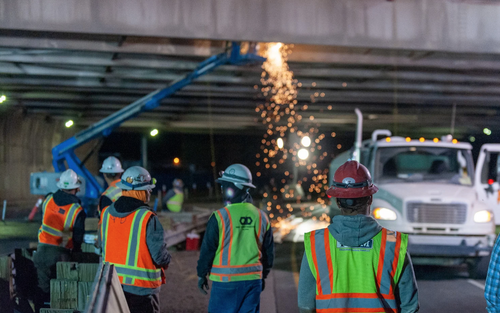4 Hidden Risks on the Construction Site
Millions of Americans work in the construction industry, from laborers to managers and beyond. Construction work puts employees at risk of many hazards because of the sheer number of conditions involved. Temperature extremes, traffic, atmospheric hazards, electrical and fire injuries, and so many other dangers are present and can result in construction accidents. Before anyone even sets foot on a build site, employers must ensure that construction site safety, including providing personal protective equipment, is a priority.
The Occupational Safety and Health Administration (OSHA) lays out the policy and equipment requirements for construction jobs as well as many other industries. Many of these risks seem obvious, but others aren’t so obvious. And this doesn’t mean that they don’t deserve your attention or can’t cause construction accidents. We have four common risks that may be overlooked, as well as the steps you can take and equipment you can use to minimize these potential hazards.
UV Radiation
The sun might seem like an obvious threat, especially during the summer when it’s beating on your neck. However, the UV radiation it produces is hazardous every day of the year and probably even more dangerous in the colder months because you’re not thinking of it as much. Overexposure to UV rays, which can even penetrate through some clothing, can lead to skin burns and cancer.
Use sunscreen all year long, even when it’s cold and cloudy out, to protect your exposed skin from the potential dangers of the sun. Use PPE that protects from this type of radiation as well: this includes UV protective clothing, eyewear that offers UV protection, and hard hats in vented and non-vented styles with UV-resistant materials and sun-blocking features like full brims and visors. And while these won’t help as much with danger from UV radiation, always have water, cooling PPE, and shade access available when working outside in warmer months.
Loud, Persistent Sounds
Loud noises seem like another obvious construction site hazard—after all, some of the tools and equipment that gets used can get extremely loud. However, the risk of sudden loud sounds isn’t the only type of noise to worry about. Quieter (but still very loud), continuous sounds also present a threat to hearing. Many workers are also likely to ignore hazardous noises throughout the workday and avoid wearing their hearing protection. This can be dangerous when construction sites can easily exceed 90 dBA—two hours of exposure at this level without hearing protection can result in permanent hearing damage. If workers are exposed to more than 85 dBs of sound for eight hours on a time-weighted average, employers must implement safety measures to prevent hearing loss, as required by OSHA’s Occupational Noise Exposure Standard.
Workers can wear earmuffs, reusable or disposable ear plugs, or hearing bands as one of the easiest and safest forms of hearing protection.
Fall Hazards
Workers and tools can end up at heights on a construction site, and just as easily, both are at risk of falling off of scaffolding and other heights onto a lower level. Even two-pound tools that seem light enough can result in severe head trauma and death when dropped from 15 feet. As for workers, all it takes is a wrong landing, even from one level, to result in permanent injury or death.
Adequate fall protection systems are necessary to prevent falls for both workers and objects—no duct tape, fabric, or string makeshift solutions here. ANSI/ISEA 121 has a consistent set of guidelines for dropped object prevention, and OSHA has requirements for employers for both workers and tools.
Visibility
Workers, equipment, and boundaries should all be visible on a job site. A lot is going on, but being alert can only go so far if conditions are too wet, foggy, or dark to adequately see dangers coming. Many of these accidents happen when workers are cleaning, repairing, directing traffic, walking on roads, or behind construction vehicles as they back up. Most accidents also happen in the evening.
Minimize these dangers with high visibility clothing such as hi-vis vests and other equipment that reflects light to make workers and gear more visible. Safety glasses that reduce glare from snow or rain are also great to use. Warning beacons are a water-resistant way to mark out boundaries and keep workers safe in areas such as vehicle paths, loading and unloading areas, no-go zones, or even clipped to worker belts.
Everyone on your team is responsible for staying safe and keeping others as safe as possible. PPE might be the last line of defense in the hazard controls needed at work, but it’s still crucial to provide these tools to mitigate risk. PK Safety has decades of experience in construction site safety and construction safety gear. Our website is always available for you to read up on the latest industry news, and you can contact anyone from our customer support team online or by calling 800.829.9580.
Recent Posts
-
The Best Cold Weather Gloves for Package Handlers and Delivery Drivers | PK Safety
Best Gloves for Package Handlers During the Holiday Season As the holiday season approaches, pa …Nov 11th 2024 -
Why Hi-Vis Winter Work Gear is Essential for Safety During the Cold Months | PK Safety
When temperatures drop and daylight hours shrink, outdoor workers face additional hazards that incre …Oct 31st 2024 -
Self Braking Descender: Advanced Rope Control for Fall Protection | PK Safety
For professionals working at heights, controlled descent is critical. Whether you’re a window cle …Oct 30th 2024





